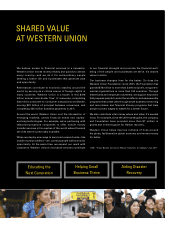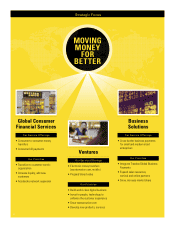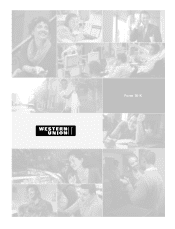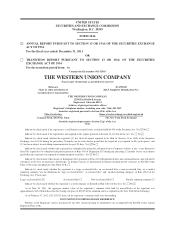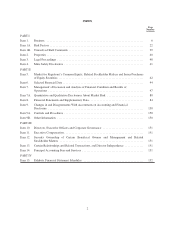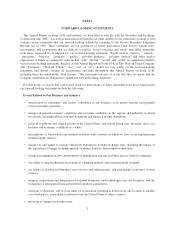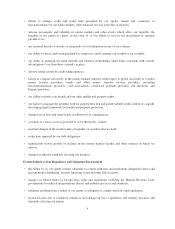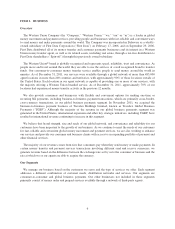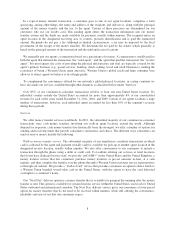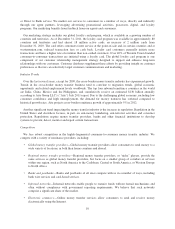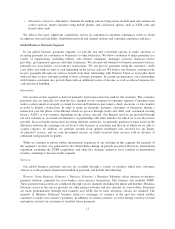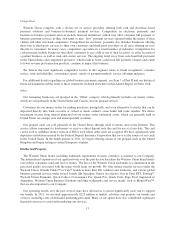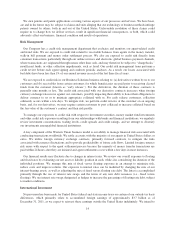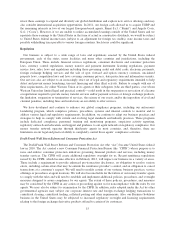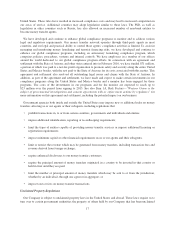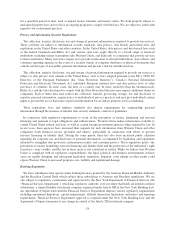Western Union 2011 Annual Report Download - page 15
Download and view the complete annual report
Please find page 15 of the 2011 Western Union annual report below. You can navigate through the pages in the report by either clicking on the pages listed below, or by using the keyword search tool below to find specific information within the annual report.In a typical money transfer transaction, a consumer goes to one of our agent locations, completes a form
specifying, among other things, the name and address of the recipient, and delivers it, along with the principal
amount of the money transfer and the fee, to the agent. Certain of these processes are streamlined for our
customers who use our loyalty card. This sending agent enters the transaction information into our money
transfer system and the funds are made available for payment, usually within minutes. The recipient enters an
agent location in the designated receiving area or country, presents identification and is paid the transferred
amount. Recipients do not pay a fee (although in limited circumstances, a tax may be imposed by the local
government on the receipt of the money transfer). We determine the fee paid by the sender, which generally is
based on the principal amount of the transaction and the send and receive locations.
We generally pay our agents a commission based on a percentage of revenue. A commission is usually paid to
both the agent that initiated the transaction, the “send agent,” and the agent that paid the transaction, the “receive
agent.” For most agents, the costs of providing the physical infrastructure and staff are typically covered by the
agent’s primary business (e.g., postal services, banking, check cashing, travel and retail businesses), making the
economics of being a Western Union agent attractive. Western Union’s global reach and large consumer base
allow us to attract agents we believe to be of high quality.
To complement the convenience offered by our network’s global physical locations, in certain countries we
have also made our services available through other channels, as described below under “Services.”
Over 85% of our consumer-to-consumer transactions involve at least one non-United States location. No
individual country outside the United States accounted for more than approximately 6% of our consolidated
revenue for each of the years ended December 31, 2011, 2010, and 2009. Certain of our agents facilitate a large
number of transactions; however, each individual agent accounted for less than 10% of the segment’s revenue
during these periods.
Services
We offer money transfer services worldwide. In 2011, the substantial majority of our consumer-to-consumer
transactions were cash money transfers involving our walk-in agent locations around the world. Although
demand for in-person, cash money transfers has historically been the strongest, we offer a number of options for
sending and receiving funds that provide consumers convenience and choice. The different ways consumers can
send or receive money include the following:
Walk-in money transfer service. The substantial majority of our remittances constitute transactions in which
cash is collected by the agent and payment (usually cash) is available for pick-up at another agent location in the
designated receive location, usually within minutes. We also offer convenience to our consumers to initiate a
transaction through the phone using a debit or credit card. To facilitate offering our services at retail locations
that do not have dedicated service staff, we provide “goCASHsm” in the United States and the United Kingdom, a
money transfer service that lets consumers purchase money transfers at pre-set amounts in-lane, at a cash
register, and then complete the transfer over the phone through a Western Union customer service representative
or through our website. We provide a “Cash to Card” service that provides consumers an option to direct funds to
a Western Union branded stored-value card in the United States, with the option to have the card delivered
overnight to a consumer’s home.
Our “Next Day” delivery option is a money transfer that is available for payment the morning after the money
transfer is sent. This option is available for certain domestic service within the United States, and in select United
States outbound and international corridors. The Next Day delivery service gives our consumers a lower-priced
option for money transfers that do not need to be received within minutes, while still offering the convenience,
reliability and ease-of-use that our consumers expect.
8


